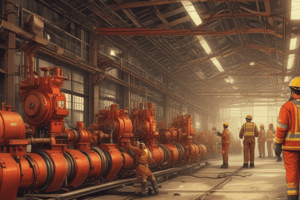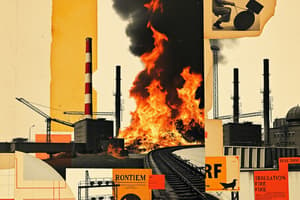Podcast
Questions and Answers
zona de riesgo A superficie de area >igual o mayor 1000 riesgo intrinseco bajo necesita hidrante
zona de riesgo A superficie de area >igual o mayor 1000 riesgo intrinseco bajo necesita hidrante
- si (correct)
- no
zona de riesgo A superficie de area >- 300 y 1000 riesgo intrinseco media necesita hidrante
zona de riesgo A superficie de area >- 300 y 1000 riesgo intrinseco media necesita hidrante
- si (correct)
- no
zona de riesgo B superficie de area >- 1000 riesgo intrinseco bajo y medio necesita hidrante
zona de riesgo B superficie de area >- 1000 riesgo intrinseco bajo y medio necesita hidrante
- si
- no (correct)
Según la UNE 23500 los hidrantes serán considerados por abastecimiento de agua
Según la UNE 23500 los hidrantes serán considerados por abastecimiento de agua
¿Cuál es la superficie mínima requerida para que un sector o área de incendio sea considerado de riesgo bajo?
¿Cuál es la superficie mínima requerida para que un sector o área de incendio sea considerado de riesgo bajo?
¿Cuál es el radio de protección que se considera para cada hidrante exterior?
¿Cuál es el radio de protección que se considera para cada hidrante exterior?
¿Cuál es el diámetro mínimo requerido para la salida de uno de los hidrantes?
¿Cuál es el diámetro mínimo requerido para la salida de uno de los hidrantes?
¿Cuál es la distancia mínima requerida entre el emplazamiento del hidrante y el límite exterior del edificio o zona protegidos?
¿Cuál es la distancia mínima requerida entre el emplazamiento del hidrante y el límite exterior del edificio o zona protegidos?
¿Qué sucede si, por razones de ubicación, las condiciones locales no permiten la instalación de hidrantes exteriores?
¿Qué sucede si, por razones de ubicación, las condiciones locales no permiten la instalación de hidrantes exteriores?
¿Cuál es el objetivo principal de los hidrantes exteriores?
¿Cuál es el objetivo principal de los hidrantes exteriores?
Flashcards are hidden until you start studying
Study Notes
Configuration of Fire Zones and Outdoor Hydrants
- The configuration of fire zones depends on the zone's surface area and intrinsic risk level.
- Types of zones:
- A: ≥ 300m², low to medium risk
- B: ≥ 1000m², medium risk
- C: ≥ 2000m², medium to high risk
- D or E: ≥ 5000m², high risk
Installation of Outdoor Hydrants
- The number of outdoor hydrants required is determined by the size of the protected area.
- Each hydrant should cover a radius of 40m, measured horizontally from the hydrant's location.
- At least one hydrant should have a 100mm outlet, preferably located at the entrance.
- The distance between the hydrant and the exterior of the building or protected zone should be at least 5m.
Water Requirements and Autonomy
- The water requirements for each zone are determined by the type of establishment and its intrinsic risk level.
- Water requirements:
- A: 500L/min, 30min autonomy
- B: 500L/min, 30min autonomy; 1000L/min, 60min autonomy; 1000L/min, 90min autonomy
- C: 500L/min, 30min autonomy; 1500L/min, 60min autonomy; 2000L/min, 90min autonomy
- D or E: 1000L/min, 30min autonomy; 2000L/min, 60min autonomy; 3000L/min, 90min autonomy
- Notes:
- When storing combustible products outside, add 500L/min to the water requirements.
- The minimum pressure at the hydrant outlet should be 5 bar.
Studying That Suits You
Use AI to generate personalized quizzes and flashcards to suit your learning preferences.


